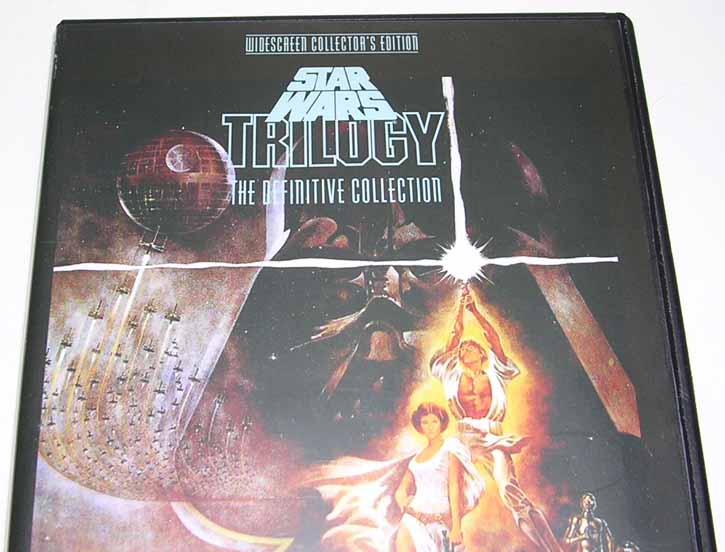
Anyone who is desperately craving copies of all of the Star Wars movies on DVD should look over the options available and think about what they want, because at this point there are good commercial copies of all six movies readily available. The discs that we have finally received from Fox prove that LucasFilm does at least provide high quality audio and video as well as some good extras, when they finally get around to releasing a title on DVD. The original trilogy's 2004 DVD release, reviewed below, makes any SE bootleg irrelevent, just as the Phantom Menace, Attack of the Clones, and Revenge of the Sith discs did in 2001, 2002, and 2005. I've retained reviews of the Phantom Menace and SE trilogy bootlegs just for the sake of amusement at this point, even though I don't recommend wasting your time on any prequel or Special Edition bootlegs. Bootleg activity continued beyond 2004, however, solely because of the changes made by Lucas to the original trilogy for the 1997 Special Edition re-release and the subsequent changes for the 2004 DVD's. Fans' desire to have a digital archive of the original theatrical versions of the trilogy led to a strong interest in bootlegs based on the 1993 or 1995 LaserDisc releases. By the time the Limited Edition discs arrived, those bootlegs had gotten surprisingly sophisticated, so I've left my reviews of those discs in place along with the reviews of the official releases. Links to each page are available below and are reproduced at the top of each review.
The void created by the lack of official DVD's for the Star Wars movies allowed for the appearance of a large, shady, and often unclear assortment of imitations and substitutes. There have been numerous bootleg versions of the Star Wars movies, created from available sources such as official Laserdiscs and Video CD's and even "borrowed" theater prints (complete with nicks and lint - from what little I've heard, the first Phantom Menace bootlegs were made this way, and were almost unwatchable). Even Attack of the Clones and Revenge of the Sith fell victim, probably due in large part to the activity surrounding bootlegs of the original trilogy. These discs provide a way to have the movies on DVD, but it comes at the cost of quality. How much quality? I've documented some of my thoughts on the Star Wars DVD's I've seen, both the excellent official releases and several of the many, many bootlegs that have materialized over the last four years or so. In general, bootleg discs are not going to be good enough to stand up against an official DVD release, although some more recent fan-organized efforts to preserve the original theatrical versions of the trilogy have attempted to disprove that notion. Some of the bootlegs, such as the first Phantom Menace discs (derived from theatrical prints), are not even as good as a worn out VHS tape. In light of the release of the trilogy on DVD in September 2004, the bootlegs are really only appealing to two types of Star Wars fan: the fan who likes to collect everything available, and the fan who is interested in preserving thr original theatrical version of the trilogy on some format other than VHS and LaserDisc. The very best of the new bootlegs can rival the widescreen VHS copies (although you don't need to rewind the DVD's, and you can watch them as often as you want without wearing them out) or even the 1993 LaserDiscs. In other cases, they aren't even as good as the VHS copies. For more information on the Star Wars bootleg DVD's, try these links to The Digital Bits.

Star Wars: A New Hope, The Empire Strikes Back, and Return of the Jedi Original Release
1993 Definitive Edition LaserDiscs transferred to dual-layer discs
It may sound odd coming from someone who has provided reviews of a number of different bootleg versions of the Star Wars movies, but I dislike the idea of movie bootlegs in general. Spending even a few dollars on a DVD-R of a movie that's still in the theater – knowing that the transfer is a non-anamorphic mess that is at best taken from a "borrowed" theatrical print riddled with dust and scratches or at worst taken from a handheld camcorder in a crowded theater – strikes me as absurd and short-sighted. DVD penetration has reached the point that the studio is sure to release a DVD with a good transfer and good audio track in a matter of months. What about catalog titles like Star Wars, though? At one time, this was the area that saw the greatest potential for bootlegs: movies that were already in people's VHS movie libraries but that weren't available on a 5" disc yet, but even that has changed significantly in recent years as studios have dipped deep into their archives in order to fully exploit the profit-generating potentials of DVD. That has yielded a wealth of reasonably-priced studio releases that offer significantly better quality than a bootleg. There remain only a few major titles that have not seen official release, dwindling the market for catalog title bootlegs (and probably boosting the bootleg efforts surrounding current theatrical releases). Four or five years ago, the Star Wars movies were at the center of the young but growing bootlegger movement: Lucas had vowed to keep all of the movies off the format until 2006, and there were thousands of DVD player owners who had bought players at least in part to be able to watch the trilogy. The most readily available bootlegs have generally been sets like the Five Star SE discs that were based on the Special Edition LaserDiscs, and while I expect to see eBay auctions offering these and similar sets for many months to come, I consider all of the SE bootlegs to already be of little or no value now that Lucasfilm plans to release official DVD's on September 21, 2004. At some point, however, people realized that this "home brewed DVD" approach also offered a chance to get the original theatrical cuts on DVD, something that Lucas has vowed never to do (a promise that he is more likely to stick to than his abandoned plans to stay away from DVD until '06). It is this branch of the Star Wars bootleg movement that looks likely to survive past the September 2004 arrival of the official DVD's. As a long-time fan of the movies, I like having the original versions (complete with the special effects that were so groundbreaking a quarter century ago but were digitally replaced in 1997) preserved in some form, even if I will most likely choose to watch the official releases more often than not once Amazon.com delivers my set this fall. Because of the ongoing interest in these original version bootlegs, I recently agreed to take a look at a second set of discs produced from the Definitive Edition LaserDiscs. From what I understand, these discs are priced comparably to TR47's DVD-R's (which are the other set based on the Definitive Edition LD's that I've reviewed), but they are based on an independently-created transfer. At the time of this writing, I have not had a chance to play through all three movies in their entirety, btu I have played through each disc at some length and compared them to the TR47 discs. If schedule allows, I will sit down and watch each from beginning to end and note any additional observations that come to mind.
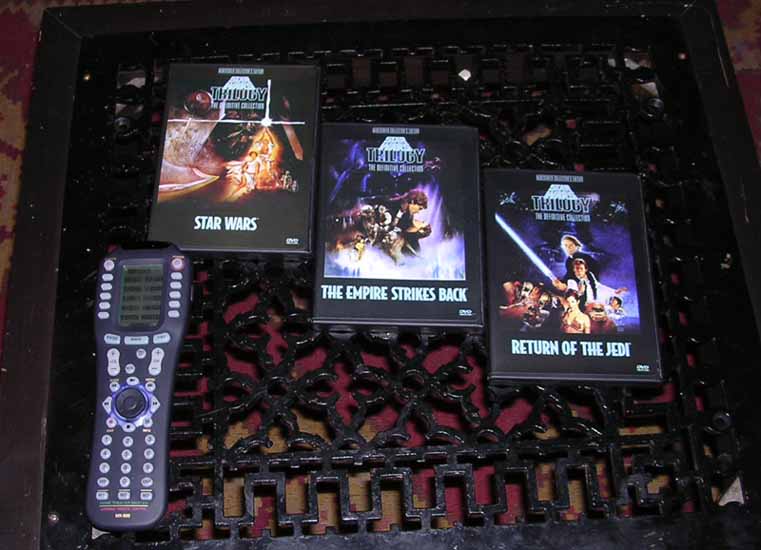
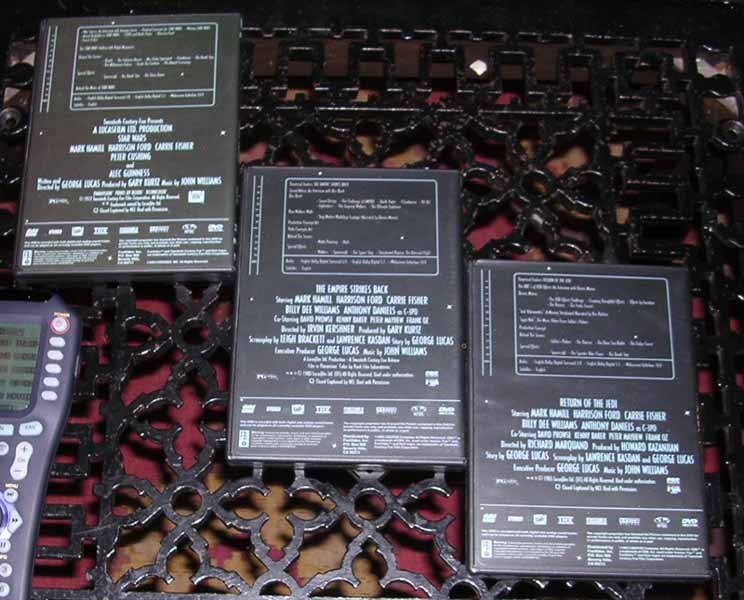
This second set of Definitive Edition bootlegs comes on three dual-layer discs. Each discs contains around 7GB of data, using all of one layer and about half of the second. The THX logo sequence that plays at the beginning of each disc is anamorphically encoded, but the menus and all other material on the disc is 4:3 or non-anamorphic letterbox widescreen. The set comes in three keepcases with cover art, liner notes, and full color disc art. Unlike the TR47 discs, the supplemental material is divided and spread across all three discs rather than being gathered on a single disc. Also unlike the TR47 discs, the original stereo soundtrack (presented as PCM audio lifted directly from the LD's on TR47's disc and here as a Dolby Digital 2.0 track) is joined by a Dolby Digital 5.1 track (the default audio option) and English subtitles are available. The discs have simple static menus, with each disc using the same format but different artwork.
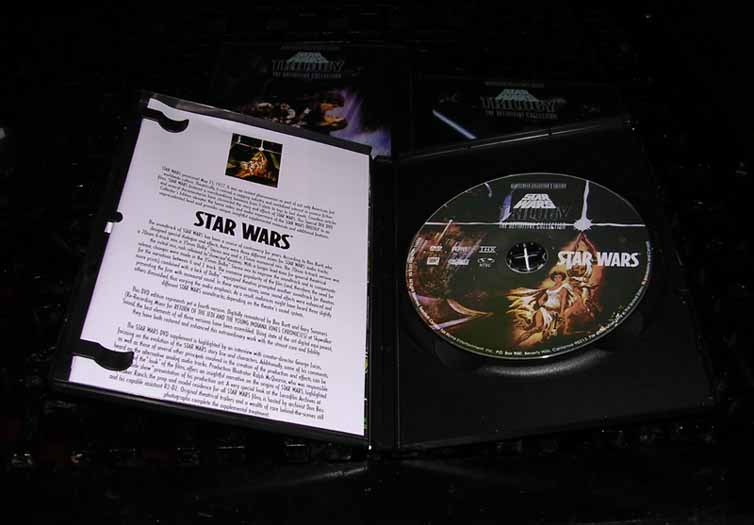
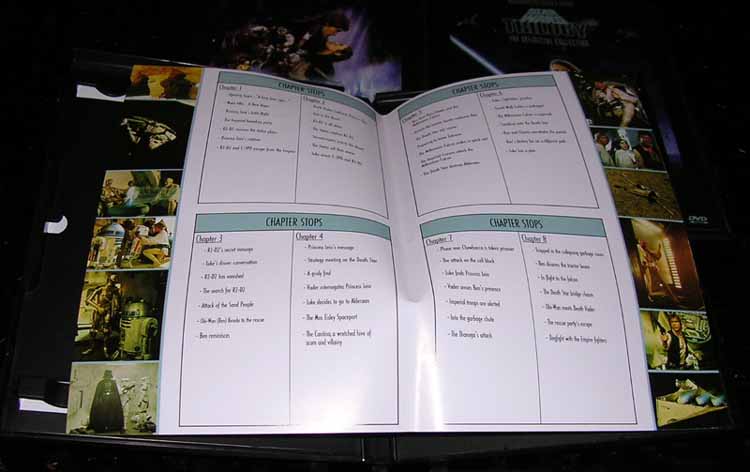
I took each movie in turn, first playing the TR47 disc and focusing on scenes that might best demonstrate the strengths and weaknesses of the transfer and then looking at the dual-layer Definitive Edition disc. All of the discs were played in the same player (an interlaced Panasonic DVD-RA60) connected via component video cables to a Zenith C32V37 32" HDTV. A New Hope was the first movie into the player. The TR47 discs have no menu, so the movie began playing automatically. On my fairly new 32" HD set, there was some light artifacting (dot crawl) around a few words in the opening scroll (on "Episode" at the top and on a few other small bits of text). This was marginal and fairly unobjectionable on my display. No artifacting was visible during the other passages I watched. Color balance on TR47's disc was excellent, with no blown out colors and a very natural feel in general. Overall, the most noticeable limitation was the slight cloudiness of the transfer, which I attributed to the source LaserDisc. The dual-layer Definitive Edition disc of A New Hope exhibited the same slight haze, reinforcing the fact that these faults are inherent in the source; it is that haze that helped prompt Lucasfilm's restoration of the movies in the 1990's. The menu is simple and functional, offering options to play the movie, set up the disc (select audio and subtitle options), go to a scene selection sub-menu, and view the extra features. The background of the top menu is somewhat cluttered, with several different text styles crowded together, but it does not impact the user interface any. There was little or no dot crawl observed during the opening scroll, offering it a slight edge over TR47's disc. The color balance on darker scenes did seem somewhat darker and less true to the original than TR47's, but as previously noted the most noticeable limitation of the transfer was the haze that already existed in the source. There was no clear winner between the two on video, with TR47's version exhibiting somewhat more artifacting in the opening scroll but also having the better color balance overall.
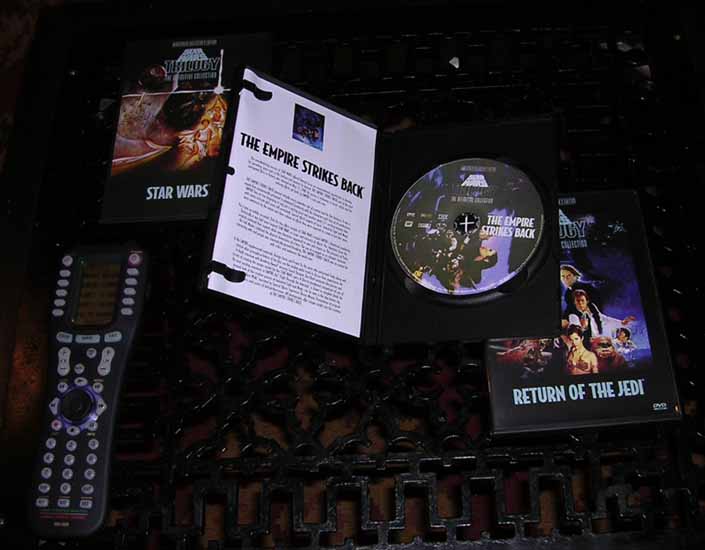
The Empire Strikes Back went next, starting with TR47's DVD-R. Dot crawl was effectively eliminated in the opening scroll here, showing a definite improvement over TR47's A New Hope. There are a few instances of compression artifacts, but they are very rare (a thin line near the bottom of Luke's flight suit suffers some artifacting briefly as he leaves Hoth). One noticeable instance occurred as the Millennium Falcon first enters the Bespin clouds, where the edges of the Falcon break up for a second or two. In this case, however, the core problem appears to be the effects shot involved and problems with the matte. Color balance remains good, albeit darker than A New Hope (done intentionally due to the darker story presented in Empire), and seems very true to the original. The dual-layer Definitive Edition version of Empire uses a menu layout similar to A New Hope, although it is somewhat less cluttered this time. Color balance is closer to that found on the TR47 version, and it seems good on both light and dark scenes. As with the TR47 version, there is some noise around the Falcon as it enters Bespin's atmosphere. As with A New Hope, there was no clear winner on video performance. In this case, the two discs are nearly identical in performance.
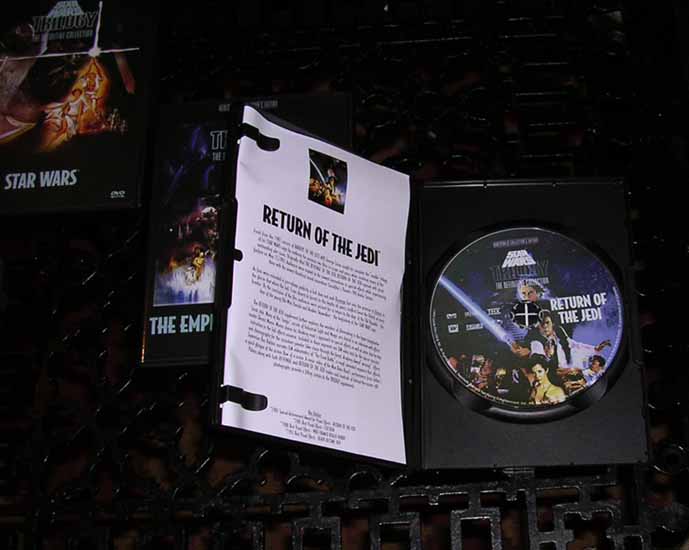
Obviously, Return of the Jedi went into the player next. The opening scroll on TR47's disc appeared very similar to TR47's Empire disc, with very minimal artifacting on a few pieces of text. It was light enough that I wondered if some of it could have carried over from the LaserDisc. Color balance remained very good. A few of the lighter scenes such as the droids' approach to Jabba's palace showed particularly good detail. The dual-layer Definitive Edition of Jedi had the cleanest menu of the bunch, retaining the same format as the others but with a simpler top menu background. Artifacts in the opening scroll were nearly nonexistent on my 32" HDTV. Here, there may be a slightly better picture offered by the dual-layer disc than TR47's, with one caveat that affects both versions which I will touch on in a moment. First, I want to briefly address the supplemental features.
TR47's set includes a fourth DVD-R containing all of the Definitive Edition supplemental material. I did not originally review this fourth disc, although TR47 provided me with a copy earlier this year and I amended my review to include it. The disc is arranged very logically, and aside from a couple of behavioral quirks in the menu the disc is very easy to get around in. With the dual-layer Definitive Edition set, the creator has spread the supplemental material across all three discs. This offers the convenience of one less disc, and from what I can tell both versions provide all of the same material, but I found the structure of TR47's bonus disc somewhat easier to find items in.
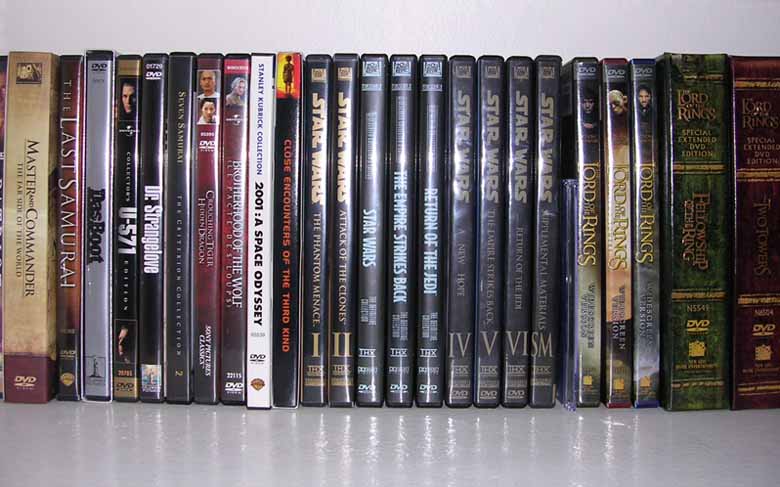
I have intentionally made no mention yet of audio on these discs. The TR47 discs use the original stereo PCM audio track, which was Dolby Pro Logic encoded and therefore decodes into surround very well using Pro Logic II (an evolution of the original Pro Logic process that was introduced by Dolby Labs in late 2001). The PCM track has also not gone through the lossy compression process required to produce a Dolby Digital 2.0 track, which may yield some benefits sonically. The dual-layer discs make use of the extra bit budget by including a Dolby Digital 5.1 soundtrack. Based on some casual listening at low volume, I found this surround sound track to be very similar to the Pro Logic II decoding of TR47's stereo track. This could be useful for someone with a Dolby Digital receiver that lacks Pro Logic II processing (Pro Logic decoding will work as well, but PL II is a significantly better process). For someone watching these discs on a two-channel system (either a stereo system or a TV's speakers), both discs are equally good. For someone with a surround sound system that support Dolby Digital but not Pro Logic II, the dual-layer discs may provide a better surround experience. If you have Pro Logic II, I'd call it a draw or a slight advantage for TR47's lossless PCM track.
So is this new version any good, and how does it compare overall to the similar TR47 version? As you can see, I currently have both versions on my shelf (the right-hand set of original trilogy cases contains both the Five Star and TR47 discs in two-disc cases plus the TR47 bonus disc). The dual-layer discs are a loner unless I choose to cough up the $30 to buy them. Both versions look and sound as good as I expect a bootleg original theatrical version DVD to look, with reasonable color balance, minimal compression artifacts and dot crawl, and good sound. Both appear to have handled the side and disc changes on the LaserDiscs very cleanly, unlike some older bootlegs that often chopped out whole seconds of film at those points. Both have chapter stops, although TR47's discs have 20 to 27 chapters each while the dual-layer discs have around 10 each. Unless Lucas changes his mind and directs Lucasfilm to produce an "archival edition" of the original cuts of these movies, we're not likely to see much more than what these two bootlegs provide. Both look fine on smaller TV's (with my 32" probably near the threshold of what they can be displayed on before beginning to break down), but because they are 2.35:1 movies presented in non-anamorphic widescreen the reduced resolution available to them begins to detract from small object detail when viewed closely. I would recommend against viewing either version on a computer monitor or a large screen TV (particularly the largest HD rear projection sets and front projectors), because viewing them in that manner will reveal loss of fine detail or a sense of "softness" to the image. For example, I noted a scene in Return of the Jedi where Han was viewed at a distance and turned to face the camera. Standing a few feet from the TV, I could see that the limited resolution had obscured his features significantly. A modern anamorphic transfer viewed on a good display would allow detail like that to be preserved, but in this case there are limitations in both the transfer process and the original source that do not allow that level of detail to survive. It's not a deal-breaker, but it deserves noting here.
Both versions represent good bootlegs, and from what I understand both are available for around $30 (which I have remarked elsewhere several times is what I consider the maximum reasonable price for a bootleg set, especially with the official release available from Amazon.com for $42). (If you are interested in this dual layer set, I'm sorry to say that I've had to remove the contact info for Kristhemovieman after getting a number of reports that he's quit distributing the discs and cut and run with several customers' money.) Anyone who already has TR47's set should not worry about needing to upgrade – the differences in the two are generally subtle and I certainly wouldn't consider them worth the $30 investment. These dual-layer discs are better packaged: while TR47 has been including a CD-R full of different cover art files for some time, you still end up with bare and unlabeled DVD-R's that you have to find a case for and print covers for. The cover art used for these discs doesn't match the covers and spines for Episodes I and II, but it's not really a glaring difference. It might even be useful to have a clearly different spine layout if you plan to pick up the official releases and set them both on the shelf. In the end, I would recommend either version to someone who is determined to have a DVD copy of the original theatrical version of the trilogy. Casual fans are still best off picking up the official release, which will look and sound better than any bootleg (they're even re-mixing the soundtrack for at least A New Hope and possibly all three using the original audio stems) and will arrive less than three months from now.
UPDATE, 12/6/2004: I've been contacted by one buyer of Kristhemovieman's discs to report some trouble getting orders delivered recently. There have also been a couple other reports over the last four to six months suggesting some flakiness on his part. As not everyone has had problems, I will leave his contact information listed above, but I am also adding this small disclaimer here that these discs are being sold by an individual through somewhat dubious distribution channels: buyer beware. Overall, I think TR47's delivery track record is the more solid (he got a bit backlogged in late September during the frenzy surrounding the official DVD release, but he handled what was a significant spike in interest in original trilogy discs pretty professionally and got back on track afterward). Of course, there's also the official trilogy DVD's, which are available from Amazon.com for around $42.
UPDATE, 10/18/2005: The buyer who contacted me last year (Chris) still has not gotten his order sorted out, and his most recent attempts to contact Kris returned with reports of a full mailbox. I've tucked my review set back in their cases and will be shipping them to Chris later today.
UPDATE, 10/28/2005: As noved above, I've removed contact information for Kris from this review. In addition to Chris's problems (mentioned in the 12/6/04 and 10/18/05 updates), I've gotten two other reports indicating that Kris has closed up shop and left some buyers high and dry.
[an error occurred while processing this directive] visits since July 1, 2004